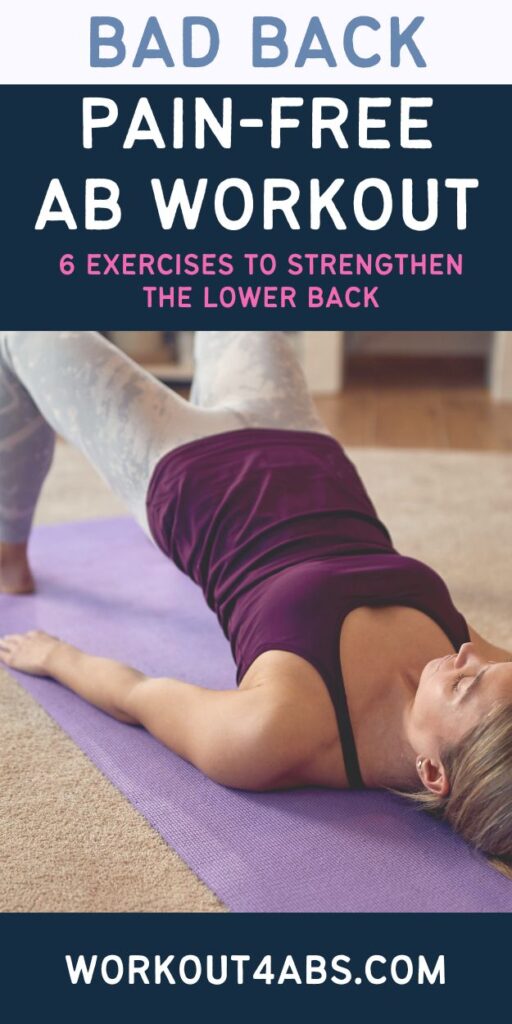Discover the ab exercises easy on back. Take this gentle path to core strength with our guide to the best ab exercises designed to be gentle on the back. Whether you’re dealing with back pain or simply aiming for a stronger core, these exercises offer effective workouts that prioritize both comfort and results.
Abs for Bad Back Workout – Pain-Free Core Strength Class! (CHALLENGE!)
6 Exercises to Strength the Core and Low Back
- Squeezing Shoulder Blades:
- Start by lying on your back with your knees bent and feet flat on the floor.
- Gently tuck your chin to lengthen your neck and maintain a neutral spine.
- Slowly and gently squeeze your shoulder blades together without arching your lower back.
- Hold the squeeze for a few seconds, then release.
- This exercise helps activate the muscles in your upper back and encourages good posture.
- Single Knee to Chest:
- Lie on your back with your legs extended.
- Gently bend one knee and bring it towards your chest while keeping the other leg straight.
- Hold your knee with both hands and feel a gentle stretch in your lower back and hip.
- Hold the stretch for a few seconds, then switch legs.
- This exercise helps stretch and mobilize your lower back and hip muscles.
- Cat and Camel:
- Begin on your hands and knees in a tabletop position.
- As you inhale, arch your back, dropping your belly towards the floor and lifting your tailbone. Lift your head to look forward (cow position).
- As you exhale, round your back like a cat, tucking your chin to your chest and pulling your belly button towards your spine.
- Alternate between arching and rounding your back, moving with your breath.
- This exercise helps improve spinal flexibility and mobility.
- Bridging:
- Lie on your back with your knees bent and feet flat on the floor, hip-width apart.
- Place your arms by your sides with your palms facing down.
- Engage your core and glutes as you lift your hips off the ground, creating a straight line from your shoulders to your knees.
- Hold the bridge position for a few seconds, then lower your hips back down.
- This exercise strengthens your glutes, hamstrings, and lower back while engaging your core.
- Lower Trunk Rotation:
- Lie on your back with your knees bent and feet flat on the floor.
- Gently drop both knees to one side while keeping your shoulders on the ground.
- Hold the stretch for a few seconds, then return to the starting position.
- Repeat on the other side.
- This exercise stretches and mobilizes your lower back and hips.
- Standing Extension:
- Stand up straight with your feet hip-width apart and hands on your hips.
- Gently lean back from your hips, arching your upper back slightly and looking up.
- Hold the stretch for a few seconds, then return to the upright position.
- This exercise helps stretch and activate the muscles in your front body.
- Quadruped Alternate Arm and Leg:
- Start on your hands and knees in a tabletop position.
- Engage your core and extend one arm forward and the opposite leg backward simultaneously.
- Keep your back straight and avoid arching or rounding your spine.
- Hold for a moment, then return to the starting position.
- Alternate between extending opposite arm and leg, engaging your core for balance and stability.
Remember to perform these exercises with controlled movements and proper form. If you have any existing injuries or medical conditions, consult a healthcare professional before attempting new exercises.
If you found this helpful and want to keep it close to you, please save this pin to your Pinterest Board.

Get rid of back pain FAST with this 12 minute routine (REALLY WORKS!)
10 Tips for Exercise with a Bad Back
Exercising with a bad back requires caution and consideration to avoid exacerbating your condition. Here are 10 tips to help you exercise safely and effectively:
- Consult a Professional: Before starting any exercise routine, consult a healthcare professional or physical therapist to ensure your chosen exercises are safe for your specific condition.
- Start Slowly: Begin with low-impact activities like walking or swimming to gradually build strength and flexibility without placing excessive strain on your back.
- Focus on Core Strength: Strengthen your core muscles, including abdominals, obliques, and back muscles, to provide better support for your spine.
- Choose Low-Impact Activities: Opt for exercises that have minimal impact on your spine, such as stationary cycling, gentle yoga, or water aerobics.
- Maintain Good Posture: Practice proper posture during exercise and daily activities to reduce strain on your back. Engage your core and avoid slouching.
- Avoid Heavy Lifting: Skip exercises that involve heavy weights or resistance, especially those that require lifting from the ground, as these can strain your back.
- Stretch Regularly: Incorporate gentle stretching into your routine to improve flexibility and relieve muscle tension. Focus on hamstrings, hip flexors, and lower back muscles.
- Listen to Your Body: If an exercise causes pain or discomfort, stop immediately. Pain is your body’s way of signaling that something is wrong.
- Use Supportive Equipment: Invest in proper footwear and exercise equipment that provide cushioning and support, such as a stable exercise mat or supportive shoes.
- Modify Exercises: If you enjoy certain exercises but find them uncomfortable, consider modifying them. For instance, you can perform wall push-ups instead of regular push-ups.
Remember, the goal is to strengthen and improve your back’s condition, not worsen it. Always prioritize safety and consult with your healthcare provider or a physical therapist to create a customized exercise plan that suits your specific needs and limitations.
If you found this helpful and want to keep it close to you, please save this pin to your Pinterest Board.

Is it possible to workout to tone the abs while experiencing back pain?
While it is possible to work on developing a six-pack while experiencing low back pain, it’s crucial to approach the process with caution and prioritize your back health. Here are some considerations:
- Consult a Professional: Before beginning any exercise regimen, especially if you have low back pain, consult a healthcare professional or physical therapist. They can evaluate your condition, provide guidance, and recommend exercises that are safe for your back.
- Focus on Core Stabilization: Core exercises that emphasize stabilization and control rather than extreme flexion (bending) can help strengthen your abdominal muscles without putting excessive strain on your back. Planks and isometric core exercises are good options.
- Modify Exercises: Choose exercises that don’t exacerbate your back pain. Avoid movements that involve excessive bending, twisting, or lifting heavy weights. For example, instead of full sit-ups, you might try crunches with proper support.
- Emphasize Flexibility: Incorporate flexibility exercises such as gentle stretching or yoga to improve flexibility in your hip flexors, hamstrings, and lower back, which can help alleviate some low back discomfort.
- Avoid Overtraining: Overtraining your abdominal muscles can lead to muscle imbalances and potentially worsen your back pain. Balance your core exercises with exercises that strengthen your back muscles as well.
- Pay Attention to Posture: Practice good posture throughout the day to reduce strain on your lower back. Proper alignment can help prevent additional discomfort.
- Progress Gradually: Gradually increase the intensity and complexity of your core exercises as your back pain improves. Avoid rushing into intense workouts that could aggravate your condition.
- Listen to Your Body: If any exercise causes pain or discomfort in your lower back, stop immediately. Pain is a signal that you might be straining your back muscles.
- Include Low-Impact Cardio: Cardiovascular exercises like walking, cycling, or swimming can improve overall fitness without putting excessive stress on your back.
- Seek Professional Guidance: Consider working with a qualified personal trainer or physical therapist who has experience working with individuals with back issues. They can design a tailored program that addresses your core strength while prioritizing your back health.
Remember that your primary focus should be on alleviating your back pain and improving your overall well-being. The appearance of a six-pack is a result of multiple factors, including diet, genetics, and consistent exercise. While it’s possible to work on your abdominal muscles, it’s essential to do so in a way that supports your back health and doesn’t worsen your condition.
If you enjoyed this info about the ab exercises easy on back and would like to keep it close to you at any time, just save this pin to your Pinterest Board.

Home › Posture Exercises ›Ab Exercises Easy on Back